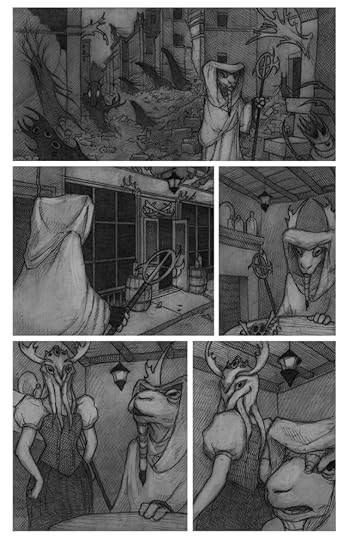Art and the Druid

Scan of an original page from The Raven’s Child, drawn by Tom Brown.
On radio 6 recently Mark Radcliff claimed that only 0.7 % of the British public own an original work of art, but in France it’s more like 73%. I have no idea if this is true. Many of us will own prints, posters, mass produced knick knacks and other interior decor. It tends to be cheaper. Why would we pay more for a work of art?
First up there’s the question of the kind of world you want to live in. Do you want the spaces we inhabit to be prettied up by mass produced banality? Without original artists somewhere in the mix, that’s what we’d get. Often what you find as a poster or print is a piece of someone’s art, or photograph, duly copied and licensed. Popular, famous work involves artists who are dead and no longer subject to copyright. It may be that you’re fine with the driven starving artist model, where people spend their whole lives working unrecognised, Van Gogh style, only to make other people vast wads of cash after they’ve died. It’s not a model I’m a fan of.
We are affected by our environments. That includes the soundscapes and visual experiences we have on a daily basis. Mood, emotion, sense of self, even which genes are switching on and off, is informed by the space we are in. How we feel about that space is an important part of the mix. When you feel emotionally invested in what’s around you, it’s different to being surrounded by things you don’t really care about.
I have four pieces of original art on the walls – 2 pieces of my grandmother’s, 1 Andrew Wood, 1 Grizelda Holderness. I also have a limited edition Walter Sickert print (Army of Broken Toys Walter, not dead might have been Jack the ripper Walter). I have art prints from Matlock the Hare, and a Dr Geof poster. I have art postcards bought directly from local artists whose originals are out of my league. Each of these involved conversation, exchange, engagement, so when I look at the prints, they feel very different to other prints I’ve owned in the past. They feel personal. Beyond this, I have a small collection of Pete Brown (no relation) pottery, A Matlock the Hare Dripple, a handcrafted Hopeless Maine doll made by a young artist, a giant goth moth, small artefacts made by arty friends a pottery dragon, and a dragon made out of a coconut shell. Other people’s creativity is an everyday part of my life.
My living space is populated by things I care about, and representations of people I care about. Now, if you’re thinking in terms of spirits of place, on in animist terms that allow for objects to have spirit, art has implications. Here is someone else’s awen made manifest. Here is someone else’s soul poured into an act of creation. Here is a gift of creativity between friends. Bought or given, the object or image someone else has made with their own hands has a different feel to something mass produced.
I firmly believe that art should be affordable for everyone. For twenty five of your English pounds, Tom Brown will carefully roll an original page from Hopeless Maine or The Raven’s Child into a tube and post it to you. For £45 you can have two and we’ll throw in a poster. If you’re outside the UK, postage is a little more expensive. Original pages (as with the image in this post) are hand drawn in graphite, and are unique – each one having gone on to be a page in a book. They aren’t quite the same as art intended to hang on a wall, but they are most certainly art, and also very cheap, even by the standards of comics pages. Leave a comment if you’re interested and we’ll email you.





